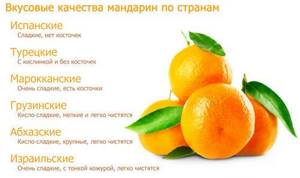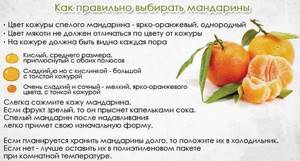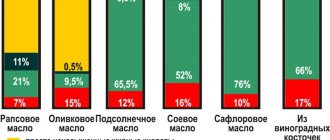Composition of mandarin
Tangerines (calorie content per 100 grams are quite low) have the following composition:
| Vitamin content | |
| Vitamin A | ˂60 mcg |
| Vitamin B1 | ˂60 mcg |
| Vitamin B2 | 30-35 mcg |
| Vitamin B3 | 0.35 mg |
| Vitamin B4 | 10 mg |
| Vitamin B5 | ˂200 mcg |
| Vitamin B6 | 80 mcg |
| Vitamin B8 | 190 mg |
| Vitamin B9 | 16 mcg |
| Vitamin C | ˂40 mg |
| Vitamin P | ˂30 mg |
Minerals:
| Potassium | 150-170 mg |
| Calcium | 35 mg |
| Phosphorus | 15-20 mg |
| Magnesium | 11-12 mg |
| Sodium | 1.5-2 mg |
| Iron | 0.1-0.15 mg |
What to cook from tangerines?
It is best, of course, to eat tangerines raw, whole with peel. But it is perfectly acceptable to use them in other ways.
For example, confectioners use tangerine slices to bake cakes and pastries. Housewives have learned to make jam from tangerines, and professional chefs prepare delicious sauces based on tangerines and often add them as a spice to cookies, fish dishes, salads, etc.
In addition, you can squeeze the most beautiful juice from tangerines. The main thing is that the tangerines are ripe and not spoiled, and the rest is a matter of technique...
The benefits and harms of tangerine
Mandarin contains most of the vitamins and minerals the body needs to maintain immunity at a high level. Components such as potassium and sodium help relieve swelling. Glycosides prevent the development of atherosclerosis of blood vessels.
Essential oils promote the production of endorphins. Phenolic acid actively helps in the treatment of diseases of the respiratory system. Fruit extract is often used in cosmetics for dry and aging skin due to its nourishing and moisturizing effects.
Also, the main beneficial properties of tangerine include:
- prevention of respiratory diseases;
- decreased blood pressure;
- tonic effect;
- improved digestion;
- prevention of helminthiasis.
Mandarin is widely known as an ingredient in medicinal folk recipes. Fresh fruit juice helps with intestinal disorders and constipation.
To get rid of nausea, you should eat the peel of the fruit. Rubbing tangerine juice into the skin helps prevent fungal diseases. Syrups containing tangerine have proven themselves effectively in the treatment of bronchial diseases. The benefits of this fruit are not comparable to the harm that can only be caused by excessive consumption .
Benefits for the body

General benefits of tangerines for the human body:
- Antioxidants and vitamin C eliminate inflammation and prevent the formation of free radicals that cause oxidative processes.
- Essential oils calm the nervous system, reduce anxiety, nausea, headaches, and normalize sleep. In Minnesota hospitals, doctors installed aromatherapy lamps in their rooms. The result of the experiment was pleasantly surprising - the patients’ condition improved significantly, anxiety and restlessness went away.
- Mandarin has antibacterial properties and reduces microbial activity.
- Citrus promotes the formation of antitumor agents and helps fight cancer.
- Pectin and hemicellulose regulate blood cholesterol levels, promote the elimination of “bad” cholesterol and increase the level of “good” cholesterol.
- Fiber normalizes digestion and stool, regulates intestinal function, heals wounds and erosions in the stomach, and reduces gas formation.
- Regular consumption of tangerines prevents the development of stroke and heart muscle cancer.
- Citrus stops the development of sepsis thanks to essential oils that destroy bacteria.
- Tangerines accelerate cell renewal and reproduction of new ones.
- The product removes uric acid, salt and harmful substances from the body.
- Tangerine essential oil relieves spasms of the respiratory system and prevents the development of asthma.
- The fruits contain lutein, the visual pigment of our eyes. Without it, we would not be able to discern details. It maintains and improves visual acuity and prevents retinal dystrophy.
For women

Tangerines normalize the menstrual cycle, eliminate smooth muscle spasms, and alleviate the condition of women during menopause. Citrus restores vitality, gives a boost of energy, and prevents the development of depression.
During the period of bearing a child, it is useful to consume a small amount of tangerines (1-2 pieces per day). This helps eliminate toxicosis, tissue swelling, and prevent the appearance of stretch marks on the skin.
Essential oil cleanses the skin, lightens acne, reduces scars and stretch marks. The delicate texture does not irritate the skin and prevents the development of bacterial and fungal infections. The oil is not used in its pure form, but mixed with almond or peach oil.
With regular consumption of tangerines, skin color improves, acne and inflammation on the face disappear, elasticity increases and the network of fine wrinkles decreases.
Ascorbic acid slows down the aging process of the skin, protects against the harmful effects of the environment, and promotes collagen production.
Vitamins A and B12 help strengthen the hair follicle and reduce the secretion of sebum, slowing down the process of graying. Hair will remain fresh longer, become manageable and shiny.
For men

Tangerines have a positive effect on potency, increase the percentage of viable sperm, and enhance libido. Regular consumption of citrus fruits increases endurance, which is especially important during increased physical activity.
For children

Tangerine contains the least amount of vitamins and minerals compared to other citrus fruits, but this does not make it a useless product. Children love the slices with their pleasant sweet and sour taste. Mandarin stimulates the digestive function of a growing body, increases appetite, eliminates diarrhea and alleviates bronchitis.
Tangerine is considered one of the most powerful allergenic foods, so it is introduced into children's diets gradually and with extreme caution. Pediatricians recommend starting to get acquainted with citrus after a year of the baby’s life. Children suffering from allergic diseases are given tangerines after 3 years of age, starting with 1-2 slices.
One-year-old children are given tangerine juice diluted 1:1 with water. Start with 1 tsp. and gradually increase the portion to 100 ml.
Harm and contraindications
Contraindications for use of the product:
- epilepsy;
- disorders of the liver (hepatitis) and kidneys (nephritis, cholecystitis);
- inflammatory processes in the intestines;
- pathologies of the gastrointestinal tract;
- children's age less than 1 year;
- gastritis with high acidity;
- allergy.
Excessive consumption of citrus fruits causes hypervitaminosis. Many vitamins are not able to accumulate, and the body does not have time to break down the large flow of nutritional components. The result is a rash, upset stomach, low hemoglobin.
Contraindications to the use of tangerines
Tangerines should not be consumed by people who have:
- individual intolerance to the fruit or its components;
- tendency to allergic reactions;
- gastritis;
- ulcer;
- nephritis;
- hepatitis;
- cholecystitis;
- diseases of the duodenum;
- high acidity of gastric juice.

Fruits from the citrus family are strong allergens and can therefore cause diathesis. It is not recommended to eat tangerines if you have inflammatory diseases of the digestive system.
Tangerines are not super perfect!
They also have a lot of negative things:
- May cause allergies.
- Exacerbate gastritis.
- Increases acidity.
- Information for those who are fans of tangerine peel!
It has both good and bad!
The bad: it should not be eaten by those who have diseases associated with the kidneys and liver.
The good: tangerine peel contains a lot of essential oils.
Calorie content of dried tangerine per 100 g
Tangerines after drying have a calorie content per 100 grams reaching 500 kcal. When preparing dried tangerines, all the vitamins remain in them, and the moisture completely evaporates. In this form, fruits can be stored for a long time and are used in many dishes.

The figure shows the calorie content of tangerines per 100 grams.
It is advisable to wash industrially dried tangerines before eating, as they are treated with substances containing sulfur. If mold appears on the fruit, it is better to refuse to eat it.
How many calories are in a tangerine - Beauty and nutrition - all about healthy lifestyle
Tangerines are among the most favorite delicacies on the New Year's table among the multi-million population of our country. And this is not without reason: after all, this fruit is not only very healthy, but also has incredible taste, and the calorie content of tangerine per 100 grams of product will please even the most punctual ladies who strictly adhere to a dietary diet.
In the USSR, people did not have the opportunity to buy tangerines in kilograms, as they do nowadays. Therefore, this fruit appeared on the table in small quantities only on the eve of the New Year, which is why it became a symbol of this magical winter holiday, which both adults and children look forward to.
The presence of tangerines on the Chinese table indicates the success and very good wealth of the family. In Japan, this fruit is associated with a symbol of a long, happy and prosperous life. Eating this juicy orange delicacy can lift your spirits and have a positive effect on the human body.
In the materials of the presented review, we will take a closer look at all the benefits and caloric content of tangerines.
Calorie content of tangerines
Many people who follow a dietary diet and constantly monitor the amount of fats, proteins and carbohydrates they consume often think about how many calories are in 1 tangerine. and whether a couple of eaten slices will harm their figure.
The level of energy value of tangerine is very low, which is about 33 kcal per 100 g of product.
| Name | Calorie content per 100 grams |
| In tangerine jam | 274 kcal |
| In tangerine juice | 36 kcal |
| In fresh tangerine | 230 kcal |
| In dried tangerine | 38 kcal |
But it is worth taking into account the fact that such a low calorie content of tangerine is indicated along with the peel.
Considering that this fruit is consumed mainly fresh and not everyone eats its crust, the country's leading nutritionists have done unique work on mathematical calculations, thanks to which everyone can find out how many calories are contained in dried fruit, jam, or how much kcal in one tangerine without peel.
Calorie content of fresh tangerines without skin
- These fruits have a wide range of uses.
- They are used to prepare:
- juices;
- liqueurs;
- jam;
- jams;
- marmalade and many more etc.
But most of the population consumes this fruit in its purified form.
Therefore, it is important to know that the energy value of one whole tangerine without skin per 100 g of product is 38 kcal, while the calorie content of one slice of this fruit will be equal to 3-5 calories.
On the shelves of the modern market there is a huge number of different varieties of tangerines, differing from each other in the originality of taste and size and, accordingly, the level of calorie content. The smallest mandarin ducks are the clementines, bred in Spain.
Their weight ranges from 40 to 70 grams. Moroccan tangerines have become very popular. They are medium in size. Their weight varies from 65 to 100 grams, and the calorie content of one fruit reaches 25–37 kcal.
Abkhazian tangerines are considered the largest, the energy value of which exceeds 50 kcal per 100 grams of product.

Energy value of dried fruits
Dried fruits have a wide range of useful substances and a very high calorie content. Regular consumption of dried fruits provides:
- improved blood circulation;
- increasing metabolic rate;
- providing an antiviral effect;
- increased tone and improved appetite.
But the energy value of such a product is 230 kcal per 100 g, and if sugar is added during the drying process, it increases to 260 kcal.
Tangerine juice
Natural sweet and sour freshly squeezed juice of ripe tangerines helps cope with the feeling of thirst even in the hottest weather.
The caloric content of tangerine juice reaches 36 per 100 grams of product, and the number of useful components is simply impressive. It contains vitamins A, E, B, PP, potassium, iron, ascorbic acid and much more. Therefore, it is very useful not only for children, but also for adults.
Tangerine jam and marmalade
- Despite the rather high energy value, tangerine jam and jam are very beneficial products for human health.
- Their regular use contributes to:
- strengthening ligaments and bone tissue;
- restoration of the performance of the heart muscles;
- strengthening the immune system.
But the high sugar content in these products can also harm the human body. Therefore, excessive consumption of such a delicacy can lead to gaining extra pounds, since its energy value is 276 kcal per 100 grams.
Composition and benefits of the product
Like any other citrus, tangerine is enriched with vitamins C. The high content of ascorbic acid not only helps strengthen the immune system, but also has a preventive effect on the oral cavity from the development of any pathological processes of inflammatory etiology, and also accelerates regeneration processes in the event of wounds and burns .
The peel of the fruit in question contains a high concentration of vitamins A and P. In addition, the fruit is rich in pectin, fiber, phytoncides and glycosides, which undoubtedly have benefits for the entire human body.
The nutritional value of tangerine is that it contains 0.8 grams of protein, 7.5 grams of carbohydrates and only 0.2 grams of fat. Moreover, the sugar content is 11% of the total mass of the whole fruit. The range of beneficial qualities of tangerines does not end there.
Their use is simply necessary to maintain full human health.
Because they contribute to:
- replenishment of the vitamin complex lost by the body during the winter period and acceleration of recovery processes for flu and colds;
- softening cough and restoring metabolism;
- providing an anti-edematous effect and ensuring the removal of mucus during bronchitis or asthma, due to the content of phenolic acid;
- preventing the formation and development of atherosclerosis and other heart pathologies;
- toning the body and providing a calming effect on the central nervous system.
How does tangerine help you lose weight?
The issue of losing weight has always been relevant for women, and tangerines are good helpers in this matter. The fat content in this fruit is very low, so it can be safely included in the diet. The advantage is the diuretic effect of tangerine and the fact that it is quickly digested by the body.

With a low calorie content, the fruit contains a lot of useful substances that help keep the body in good shape and not gain weight. The fruit is great for daytime snacking and replaces high-calorie desserts, but you should limit yourself to 3-4 tangerines per day.
Scientists have proven that flavonoids in citrus fruits help fight excess weight. Tangerines also speed up metabolic processes in the body, which is important for weight loss. The big advantage is that tangerines can be eaten almost all year round. Nevertheless, the organic acids in the fruit can provoke an increase in appetite, so it should be consumed in moderation.
Calorie content of tangerine: how many carbohydrates, glycemic index - Rural Life
Tangerines are one of the most delicious and healthy fruits. Most often they are consumed fresh in winter. Due to the low calorie content of tangerine, it is often used in the preparation of dietary menus.
Number of calories in tangerines
Calorie content of tangerine
Mandarin is classified as a dietary product because it contains about 47 kcal per 100 g. The calorie content of one tangerine varies from 37 to 53 kcal. It also depends on the variety and degree of ripening of the product. Knowing how many calories are in a tangerine and what its nutritional value is, they create an individual diet.
Calorie content 1 pc. tangerine without peel is about 27 units. There are about 400 kcal in 1 kg.
Average content of BJU (per 100 g):
- proteins - 9.34 g;
- fats - 0.12 g;
- carbohydrates - 8.73 g.
Pakistan, Morocco and Sicily are considered the birthplace of these fruits. But the Turkish mandarin has the most pleasant aroma.
Composition of mandarin
Mandarin contains vitamins C, D, PP, K, A, B1, B2, B6. Chemical value (mg) per 100 g of fruit:
- calcium - 34, 56;
- magnesium - 1.23;
- sodium - 12.36;
- phosphorus - 17.58;
- potassium - 155.84;
- iron - 0.11;
- dietary fiber - 1.89.
A special feature of tangerines is that they do not accumulate nitrates, which is why they are used in medicinal and dietary menus.
These orange fruits are also called the “vitamin bomb” because they effectively restore vitamins lost during the autumn-winter period.
Due to the large amount of phytoncides in their composition, these fruits have antipyretic, antimicrobial and anti-inflammatory effects.
Tangerines also help cleanse the body of toxins and reduce the amount of sugar in the blood. Tangerine juice contains a lot of beta-carotene and folic acid, which helps strengthen teeth and cope with stress.
Benefits of tangerine peel
Most often, the peel of the fruit is thrown away. However, it also brings benefits. useful elements in the peel:
- pectins;
- provitamin A;
- sugar;
- vitamins C, P, B;
- flavonoids;
- organic acids.
The essential oil contains citral, alcohols, alpha-limonene, methyl ether, so you should not get rid of the peel. It contains few calories, so infusions, teas and compotes are drunk from it while losing weight. These drinks are also useful for pregnant women: they effectively eliminate toxicosis.
Beneficial features
Fruits saturate the body with vitamins
Although the calorie content of tangerines is low, they quickly saturate the body with a complex of vitamins. This is especially important in the autumn-winter period. Ascorbic acid and phytoncides help get rid of cough and have a diuretic effect.
Phenolic acid helps cure bronchial diseases. Mandarin lowers blood sugar levels and prevents the development of heart disease.
Contraindications
The benefits and harms of fruits depend on the presence of contraindications in a person. Citrus fruits often cause allergies. Although 1 tangerine is low in calories, the diet should be abandoned if hives or other adverse reactions occur.
Also, the use of this product is harmful for the following diseases:
- nephritis;
- ulcer;
- cholecystitis;
- gastritis;
- enteritis;
- increased stomach acidity.
Eating citrus fruits can cause an allergic reaction, especially in children. Often the reason for this is the substance with which the fruits are treated before transportation - it is important to wash them thoroughly before use.
If any allergic reactions occur, the fruit is immediately removed from the menu and antihistamines are taken. If unpleasant symptoms do not disappear, you need to consult a specialist and undergo a course of treatment.
Signs of an allergy to citrus fruits:
- runny nose;
- rash, itching, redness;
- tearfulness;
- hearing impairment;
- hard breath.
Tangerines for weight loss
Tangerines are especially useful for weight loss. They can supplement your diet, arrange a fasting day, or go on a tangerine diet.
Do not consume these fruits in too large quantities: this will cause yellowing of the skin.
Tangerine Diet
The calorie content of 1 tangerine is low, which is why diets based on this product are so popular. They come in several types. If you eat 1-2 pieces of fruit daily and reduce the total amount of food, after 7 days your figure will become much slimmer.
Diets based on tangerines are effective
There is a mono-diet that lasts 3-4 days. During this period, they eat only orange fruits and drink regular still water. During this time, it is possible to lose up to 4 kg of excess weight and improve the general condition of the body.
There is also a diet lasting 10 days, with its help you can lose up to 7 kg. It includes:
- breakfast - 1 piece of fruit and a cup of green tea without sugar;
- lunch - 3 tangerines and a boiled egg;
- lunch - 1 orange fruit and 150 g of boiled chicken fillet;
- dinner - vegetable soup and 1 fruit.
After losing weight, it is important to consolidate the result. To do this, it is useful to drink 1 liter of tangerine juice every evening. It's better to cook it yourself. It is also important to move a lot and monitor the number of calories in the menu.
Tangerines in cooking
There are many recipes for delicious dietary dishes with these fruits, although the calorie content of tangerines per 100 g is low. For fruit jelly with tangerine take:
- large tangerine;
- one medium sized banana;
- water - 300 ml;
- gelatin - 10 g;
- fructose - 20 g;
- ground cinnamon.
Grind the fruits using a blender, add cinnamon. Gelatin is diluted in water and heated in a water bath, then all the ingredients are mixed, poured into molds and left to harden in the refrigerator. The calorie content of this sweet dessert is only 48 units.
Is it possible to eat tangerines in the evening while losing weight?
It is advisable to eat tangerines in the morning or before lunch due to their high content of simple sugars and carbohydrates. This product is not one of the lowest calorie and dietary products, but 1-2 fruits a day will only benefit the body. If you eat tangerines at night, carbohydrates can be deposited in unwanted extra pounds.
But if dinner consists of tangerine in combination with protein foods, this will prolong the feeling of fullness and slow down the process of carbohydrate absorption. This diet will not cause heaviness in the stomach or discomfort. If you are on a strict diet, it is better to eat tangerines no later than 5 pm.
Calorie content of peel and zest
When determining your calorie intake, it is important to calculate the nutritional value of each meal, including snacks. Often people ignore the need to count the calorie content of all foods that enter the body. Because of this, it becomes difficult to calculate the exact caloric content of the diet.
When using peels and zests, it is necessary to take into account that, regardless of the variety, they contain 34-38 kcal.
There is no need to stop eating the crust. Some people add it to baked goods, others make candied fruits or use it in making infusions. The peel and zest contain beta-carotene, vitamins A and P, which are necessary to improve heart function and prevent disorders in the functioning of the vascular system. Also includes:
- glycosides;
- phytoncides;
- pectin;
- cellulose;
- organic acids.
We recommend that you read: Drying tangerines for decoration
Regular consumption of tangerines with skin prevents the formation of cholesterol plaques. This method of eating fruits helps normalize digestion and relieve cough.

Tangerine diet: basic principles, menu for 3 days
Mandarin (calorie content per 100 grams is about 35 kcal) includes a large amount of fiber. Thanks to this, digestion processes are accelerated and a feeling of fullness comes. Pectin in the composition gives the body energy, and flavones promote weight loss. The substances contained in tangerine break down fats and speed up metabolism.

Thanks to research, scientists have found that this fruit provokes the burning of fat in the abdominal area and prevents fatty liver.
Tangerine juice is not the most optimal dietary product, but it can still be included in the menu if:
- drink juice in the morning;
- do not combine with high-calorie ingredients;
- consume with fermented milk products.
You should eat no more than 200 g of tangerines per day so as not to disrupt your proper nutrition regimen.
The fruit goes best with the following products:
- porridge (rice, oatmeal);
- low fat meat;
- seafood;
- fruits, berries, other citrus fruits;
- dairy products.
You should not combine tangerines with legumes and dishes containing starch. Regular fasting days with tangerines are one of the effective methods of losing weight. Once a week, you can limit the menu to this fruit, if there are no diseases of the digestive system.
You can eat no more than 1 kg of tangerines per day, while drinking enough water. Fasting days can be repeated 3-4 times a month, on subsequent days limiting your consumption of flour dishes and desserts.

One of the popular ones is the egg-tangerine diet. In 4-5 days you can lose 2-4 kg. Daily diet: 4-5 eggs and 3-4 tangerines. The servings alternate between eggs, tangerines and egg whites. You need to eat every 2 hours, and drink more fluids during breaks.
Sample diet menu with tangerines for 3 days:
| 1 day | breakfast | oatmeal with tangerine slices |
| dinner | boiled chicken, lettuce leaves | |
| dinner | tangerine, glass of kefir | |
| Day 2 | breakfast | rice porridge, tangerine |
| dinner | baked duck with vegetables | |
| dinner | fruit salad | |
| Day 3 | breakfast | salad with seafood and tangerine |
| dinner | boiled eggs, vegetable salad | |
| dinner | cottage cheese, tangerine |
Mandarin can be used as a spice for rice, meat and fish dishes, and in sauces. The fruit can be a component of various salads and baked dishes.
Beneficial features
Mandarin is rich in vitamin C, which is contained in one piece at a level of 42.2%, thanks to which consumption of the product strengthens the immune system. Ascorbic acid takes part in redox reactions and increases the absorption of iron. Other beneficial properties of the fruit:
- Tangerines have a beneficial effect on the digestive tract, speed up metabolism and eliminate dysentery.
- The fruits have an antibacterial effect, so their juice is used to treat skin diseases.
- The fruit is used for severe bleeding as a hemostatic agent.
- Dried tangerine peel is brewed as tea. This drink has a sedative effect.
- Tangerine decoction for inhalation procedures helps improve health in case of respiratory diseases and problems with the respiratory system.
Consumption of tangerines:
- reduces thirst at elevated body temperature due to influenza;
- reduces the risk of heart and vascular diseases;
- reduces blood cholesterol;
- regulates insulin in patients.
If you have any medical conditions, you should consult your doctor before consuming tangerine.
For weight loss
Regular consumption of tangerines helps prevent fatty liver. Fruits help reduce fat accumulation in the abdominal cavity. It has been proven that if you drink tangerine juice and do physical exercise, you can easily lose excess weight.
There is a special diet that helps you get rid of excess body weight. For 4 days you need to eat 1 kg of fruit, drink tea without sweet additives, juice and exercise. This way you will be able to get rid of 5 kg.
You can eat tangerine to prevent the accumulation of extra pounds thanks to the flavonoids in its composition.
Dietary recipes with tangerines
There are many culinary recipes that include tangerines and allow you to maintain your figure.
Hawaiian pudding
Ingredients:
- milk – 1 l;
- rice – 1 glass;
- tangerines – 2 pcs.;
- orange – 1 pc.;
- apple - 1 pc.;
- banana – 1 pc.;
- cherry – 200 g;
- water – 600 ml;
- sugar – 150 g;
- raspberry jam – 1 tbsp;
- vanillin – 1 g.
Bring milk to a boil, add rice and sugar. Cook for 15 minutes over low heat, add vanilla. Stir and leave until the liquid is completely absorbed. Peel the fruits, divide them into slices, cut apples and bananas. Boil fruit syrup and add jam. Place the resulting pudding on a plate, put fruit on top, and pour syrup over it. Serve immediately after serving.
Fruit salad
Compound:
- tangerines – 3 pcs.;
- bananas – 2 pcs.;
- kiwi – 2 pcs.;
- apples – 2 pcs.;
- low-fat yogurt – 100 g.

Peel the fruits, cut into cubes, mix. Season the salad with yogurt. You can sprinkle orange zest on top, decorate with prunes, dried apricots, and nuts. You can add berries depending on the season.
Canned tangerine and apple compote
Ingredients:
- tangerines – 4 large;
- apples – 2 pcs.;
- sugar – 150 g;
- water – 1 l.
Wash and peel the tangerines thoroughly. Cut the peel into thin strips. Divide the tangerine into slices. Peel the apples and cut into cubes. Place zest, apples and tangerine slices into boiling water. Cook for 10 minutes, add sugar, cool. Next, pour the compote into jars and tighten.
Light salad with tangerines
Components:
- chicken fillet – 350 g;
- shrimp – 200 g;
- tangerines – 5 pcs.;
- yogurt – 500 ml;
- celery – 6 pcs.;
- greenery;
- salt.

Boil chicken fillet in salted broth. Cut the meat into small pieces. Wash the celery, peel and cut into cubes. Peel the tangerines and divide into slices. Cook shrimp for 3 minutes. Place the ingredients in a glass, add salt and pour over yogurt. Garnish the salad with fresh herbs.
All of the recipes listed are low in calories and fit well into the diet menu.
Use in cooking
Most often, tangerines are consumed as an independent dessert. In addition, slices are added to various culinary dishes, fruit salads, fresh juices, sauces, gravies for ice cream, curd mass and yoghurt are prepared from them. The product is combined with chicken, veal, some types of fish, fruits, vegetables and milk.
Tea is prepared from the zest of this exotic fruit and added to alcoholic drinks.
Dried and sun-dried tangerines have special taste qualities. But they are, rather, an exquisite gourmet product than a means to improve health, since the citrus loses some of its beneficial properties. Dried fruits are consumed as a delicious delicacy.
What a quality tangerine should be like: tips for choosing citrus
Different varieties of tangerines differ in:
- taste;
- color;
- aroma;
- acidity.
One of the sweetest fruits is the Pixie variety. It has juicy pulp with virtually no seeds and a peel with pronounced pores. Satsuma tangerines are sweet and sour and have thick skin. Their lobes are of different sizes.

Hybrids of tangerine with grapefruit and orange have greater sweetness and brighter color. Tangerine peels may be treated with harmful chemicals, so it's worth paying attention to their color and texture.
You should not buy fruits if the following are noticeable on the skin:
- white coating;
- stickiness;
- waxy shine;
- damage and bruises;
- brown spots.
Tangerines must be washed before consumption and it is better not to eat the peel, as the fruit is often processed for long-term storage. If the fruit is frozen, the peel looks wrinkled and thin. Fruit infected with parasites has dark spots of rot.
The taste of fruits depends on where they are grown:
- Tangerines from Abkhazia have pronounced acidity, small size, and yellow-orange skin. The fruits are easy to peel and contain few seeds.
- Fruits from Turkey are honey-sweet and contain many seeds. The peel is bright orange and difficult to separate.
- Spanish tangerines are deep orange, sweet and sour, and contain few seeds. The fruits are large, with thick skin.
- Tangerines from Morocco are flattened, with a yellow tint, and seedless. The fruits are sweet and juicy.
- Israeli tangerines are dry, thin-skinned and have a sweet taste.
When buying tangerines, you should pay close attention to their appearance. The fruits must be clean, without spots or streaks. The color of the fruit is uniform. The peel should not be shiny or sticky. The richer the color of the tangerine, the sweeter its taste. If you lightly press the skin, the juice should come out.

Large tangerines have a sour taste. The fruit should have a fresh citrus aroma. The fruit should be elastic and without damage. Mandarin (calorie content of fruit per 100 grams is 35 kcal) is a healthy and valuable fruit that must be included in a healthy diet.
How to select and store

Rules for choosing fruit with excellent taste:
- Give preference to weighty fruits - the greater the weight, the juicier the pulp.
- The sweetest tangerines have a bright orange, dense peel and weigh more than the sour ones. Such fruits contain the maximum amount of vitamin A.
- The skin should be free of mold, soft spots and dents. Their presence indicates a violation of the rules of storage and transportation.
- Flattened, large-fruited fruits with yellow skin, often sour.
- Press your fingernail on the skin - if the juice splatters, it means the fruit is ripe.
Storage rules:
- After purchasing, store tangerines in the refrigerator. There they stay fresh for more than a week. Rinse them with warm water, wipe dry with a waffle towel and store.
- Tangerines are best stored in high humidity conditions. Place fruits in the fruit and vegetable compartment.
- A plastic bag is not the best option for maintaining product freshness. Replace it with a regular mesh. Most often, packaged tangerines are sold in them.
- To increase shelf life, rub the fruits with refined sunflower oil.
- Tangerines with ponytails stay fresh longer.
This is interesting:
What is a pomegranate, is it a citrus or not?
Is it possible to drink carrot juice during pregnancy?
A nourishing buckwheat diet for 10 days for safe weight loss.
Storage periods and features
After purchase, it is recommended to store tangerines in trays and the bottom shelf of the refrigerator. The approximate period is 10 days. But you shouldn’t wrap it in cellophane. There they quickly deteriorate and feel bad. You can place them on a special mesh, wrapping each fruit in paper and store for up to 1 month.

Many people believe that lemon is the best remedy for colds due to the largest amount of beneficial substances. However, this is a myth. Tangerines are no worse than their counterparts. If you eat 2 fruits a day, they will begin to fight pneumonia, thin and remove mucus, and reduce the temperature during colds. This is an excellent remedy for bronchitis and pleurisy.
It can be eaten exclusively by everyone in the absence of contraindications, especially women and children. Mandarin is an excellent preventative against excess fluid retention in the body for pregnant women. Relieves depression and chronic fatigue, has a beneficial effect on skin and hair. The product is low-calorie and helps during cold and flu epidemics no worse than classic lemon.
Cautions
Tangerines, like all citrus fruits, quite often cause food allergies, so nutritionists do not advise pregnant women to overuse the fruit. Excessive consumption of citrus fruits can adversely affect the health of the expectant mother and also harm the baby. In addition, doctors strongly recommend washing fruits before consumption, since most of them are susceptible to chemical treatment during transportation.
This sweet citrus is also prohibited for people with ulcers, gastritis and other diseases of the digestive organs, especially during periods of exacerbation of the disease.
Tangerine should be introduced into children's diets slowly, starting with small doses (a few drops of juice).











